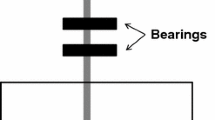Abstract
Diatoms are tenacious fouling organisms and have been observed to remain on ship hull coatings at speeds in excess of 30 knots. This study was designed to investigate the adhesion of diatoms to three fouling release ship hull coatings, Intersleek 700 (IS 700), Intersleek 900 (IS 900), and Hempasil X3 (HX3) and one reference coating Dow Corning 3140 (DC 3140), that were exposed at a static immersion test site. The coatings were subjected to water jet testing to determine biofilm adhesion and the subsequent pressures needed to remove specific diatom species. Differences in community composition were observed among coatings in the pre and post water jet evaluation. All diatoms were removed from HX3 after 0.08 MPa; however, the pressure required to completely remove biofilm and diatoms on DC 3140, IS 700, and IS 900 varied. Biofilm removal pressure ranged from 0.08 to 0.40 MPa on DC 3140, 0.16 to 0.40 MPa on IS 700, and 0.08 to 0.40 MPa on IS 900. Significant differences were observed among coatings for removal pressure, as well as initial diatom abundance; however, differences were dependent on the sampling date. The diatom genera which required the highest pressure for removal from the fouling release coatings were Achnanthes, Amphora, Cocconeis, Navicula, and Synedra. The results show differences in the adhesion strength of diatoms to different fouling release coatings and highlight those species, which have the potential to contribute to biofilms remaining on ship hulls once a vessel is underway.



Similar content being viewed by others
References
BS EN 14407 (2004) Water quality—guidance for the identification, enumeration, and interpretation of benthic diatom samples from running waters. BSI British Standards, Brussels
Callow ME (1986) Fouling algae from ‘in-service’ ships. Bot Mar 29:351–357
Cassé F, Swain GW (2006) The development of microfouling on four commercial antifouling coatings under static and dynamic immersion. Int Biodeterior Biodegrad 57:179–185
Finlay JA, Callow ME, Ista LK, Lopez GP, Callow JA (2002) The influence of surface wettability on the adhesion strength of settled spores of the green algae Enteromorpha and the diatom Amphora. Integr Comp Biol 42:1116–1122
Finlay JA, Schultz MP, Cone G, Callow ME, Callow JA (2013) A novel biofilm channel for evaluating the adhesion of diatoms to non-biocidal coatings. Biofouling 29:401–411
Gawne B, Wang Y, Hoagland KD, Gretz MR (1989) Role of bacteria and bacterial exoploymer in the attachment of Achnanthes longipes (Bacillariophyceae). Biofouling 13:137–156
Hodson OM, Monty JP, Molino PJ, Wetherbee R (2012) Novel whole cell adhesion assays of three isolates of the fouling diatom Amphora coffeaeformis reveal diverse responses to surfaces of different wettability. Biofouling 28:381–393
Holland R, Dugdale TM, Wetherbee R, Brennan AB, Finlay JA, Callow JA, Callow ME (2004) Adhesion and motility of fouling diatoms on a silicone elastomer. Biofouling 20:323–329
Hunsucker KZ, Koka A, Lund G, Swain GW (2014) Diatom community structure on in-service cruise ship hulls. Biofouling 30:1133–1140
Krishnan S, Wang N, Ober CK, Finlay JA, Callow ME, Callow JA, Hexemer A, Sohn KE, Kramer EJ, Fischer DA (2006) Comparison of the fouling release properties of hydrophobic fluorinated and hydrophilic PEGylated block copolymer surfaces: attachment strength of the diatom Navicula and the green alga Ulva. Biomacromolecules 7:1449–1462
Lewthwaite JC, Molland AF, Thomas KW (1985) An investigation into the variation of the skin frictional resistance with fouling. Trans RINA 127:268–279
Mieszkin S, Martin-Tanchereau P, Callow ME, Callow JA (2012) Effect of bacterial biofilms formed on fouling-release coatings from natural seawater and Cobetia marina, on the adhesion of two marine algae. Biofouling 28:953–968
Mieszkin S, Callow ME, Callow JA (2013) Interactions between microbial biofilms and marine fouling algae: a mini review. Biofouling 29:1097–1113
Molino PJ, Wetherbee R (2008) The biology of biofouling diatoms and their role in the development of microbial slimes. Biofouling 24:365–379
Molino PJ, Childs S, Eason Hubbard MA, Carey JM, Burgman MA, Wetherbee R (2009) Development of the primary diatom microfouling layer on antifouling and fouling release coatings in temperate and tropical environments in Eastern Australia. Biofouling 25:685–694
Schultz MP, Bendick JA, Holm ER, Hertel WM (2011) Economic impact of biofouling on a naval surface ship. Biofouling 27:87–98
Swain GW (2010) The importance of ship hull coatings and maintenance as drivers for environmental sustainability. Proceedings of RINA Conference Ship Design Operation for Environmental Sustainability. Royal Institute of Naval Architects, London
Swain GW, Schultz MP (1996) The testing and evaluation of non-toxic antifouling coatings. Biofouling 10:187–197
Swain GW, Nelson WG, Preedeekanit S (1998) The influence of biofouling adhesion and biotic disturbance on the development of fouling communities on non-toxic surfaces. Biofouling 12:257–269
Thompson S, Taylor A, Brownlee C, Callow M, Callow J (2008) The role of nitric oxide in diatom adhesion in relation to substratum properties. J Phycol 44:967–976
Woods DC, Fletcher RL (1991) Studies on the strength of adhesion of some common marine fouling diatoms. Biofouling 3:287–303
Woods DC, Fletcher RL, Jones EBG (1986) Diatom fouling of in-service shipping with particular reference to the influence of hydrodynamic forces. In: Round FE (ed) Proceedings of the ninth International Diatom Symposium. Biopress, Bristol, pp 49–59
Zargiel KA, Swain GW (2014) Static vs dynamic settlement and adhesion of diatoms to ship hull coatings. Biofouling 30:115–129
Zargiel KA, Coogan JS, Swain GW (2011) Diatom community structure on commercially available ship hull coatings. Biofouling 27:955–965
Acknowledgments
The authors would like to thank the members of the Center for Corrosion and Biofouling Control for their help in the field and laboratory. This work was funded by the Office of Naval Research Grant N00014-02-1-0217.
Author information
Authors and Affiliations
Corresponding author
Rights and permissions
About this article
Cite this article
Hunsucker, K.Z., Swain, G.W. In situ measurements of diatom adhesion to silicone-based ship hull coatings. J Appl Phycol 28, 269–277 (2016). https://doi.org/10.1007/s10811-015-0584-7
Received:
Revised:
Accepted:
Published:
Issue Date:
DOI: https://doi.org/10.1007/s10811-015-0584-7




